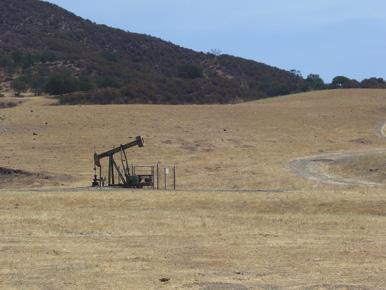
Oil company could start drilling in San Benito County
An Ojai-based oil company could start drilling in San Benito
County within months, if county planning commissioners approve the
project.
Five Oaks officials own the land, a 13,000-acre cattle ranch
near the Monterey County border south of Pinnacles National
Monument. Nahabedian Exploration Group officials have the mineral
rights.
Oil company could start drilling in San Benito County
An Ojai-based oil company could start drilling in San Benito County within months, if county planning commissioners approve the project.
Five Oaks officials own the land, a 13,000-acre cattle ranch near the Monterey County border south of Pinnacles National Monument. Nahabedian Exploration Group officials have the mineral rights.
Under the Williamson Act, mineral rights are separate from surface rights, said Tom Slavich, county assessor for San Benito County. Three-quarters of the county is covered under the act.
“It’s usually exploratory wells that they request,” Slavich said. “If it looks like it’s feasible, then they’ll do more. They probably assume something’s down there.”
Despite repeated calls over several weeks, Nahabedian officials could not be reached by press time.
If exploration is successful, Nahabedian officials would drill 18 wells on 16 acres, Slavich said.
“All the wells are close together and they are right next to the Monterey County line,” said Byron Turner, assistant director of planning and building for San Benito County.
Jeff Schmidt is a retired rancher who has lived near Five Oaks since 1980.
“It wouldn’t bother me one way or another,” Schmidt said. “I think we can use a little more oil. It would be better then bringing it in from Saudi Arabia or something.”
There are already a small handful of developed oil fields in San Benito County, all of them in remote south county sites.
There are quite a few steps that Nahabedian officials must go through before they can start drilling, Slavich said.
The planning department received an application for the project in September 2007, Turner said.
Planning staff was waiting for county officials to determine that the project is compatible with the Williamson Act, a requirement.
Slavich approved the request at the June 25 County Planning Commission meeting, according to a Web site from the planning commission.
County staff will process the application like any project, Turner said.
“We look at it for completeness and we get comments from other departments,” Turner said. “Eventually it will go to the planning commission.”
Staff Oil, Gas and Geothermal, a division of the California Department of Conservation, will also review the application, Turner said.
“They’re much more strict than the county is,” Turner said. “They will tell us what conditions need to be followed. They’re the experts on this. We have already given [the application] to them.”
Approval could happen quickly.
Before it goes to the planning commission, there will be an environmental review, Turner said. The project’s timeline depends on that review.
Under state law, some projects must be analyzed in an Environmental Impact Report (EIR), which can take a year or longer to complete.
“You don’t see too many EIRs in this county, but I don’t know,” Turner said.
Based on the initial environmental review, county officials could issue a negative declaration of impact, which means that the project has little impact on the environment.
If the project receives a negative declaration, approval could happen within months, Turner said.
A project of this scale would not normally require an EIR, said Art Henriques, director of planning and building for San Benito County.
“If somebody came in and wanted to put 50 or 100 oil wells in, that would require an EIR,” Henriques said.
If approved by planning commissioners, the project can proceed, Slavich said.
“It will only go to the board [of supervisors] if there is an appeal,” Slavich said.
Despite a thorough search of the Internet, it is difficult to find much information about Nahabedian.
“They operate most effectively when they’re underneath the public’s radar screen, so they probably have their own reasons for not calling you back,” said Jeff Kuyper, executive director of Los Padres Forestwatch.
In 2007, Nahabedian officials tried to drill in Arroyo Grande near the border of Los Padres National Forest.
“They certainly have an aggressive push to start drilling for oil in these pristine wild lands,” Kuyper said.
Although the land was privately owned, federal government officials owned the mineral rights. Nahabedian was the winning bidder for mineral rights on some of the parcels.









